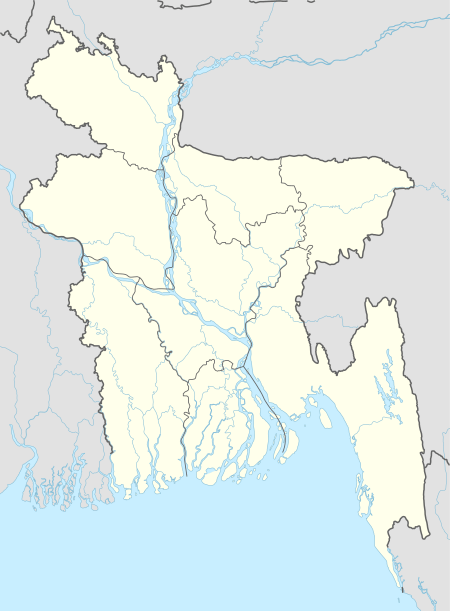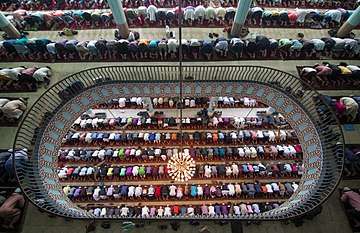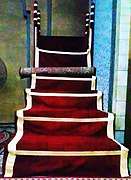Baitul Mukarram National Mosque
| Baitul Mukarram National Mosque | |
|---|---|
|
বায়তুল মোকাররম জাতীয় মসজিদ بيت المكرّم المسجد الوطني | |
.jpg) | |
 Location in Bangladesh | |
| Basic information | |
| Location |
|
| Geographic coordinates | 23°43′46″N 90°24′46″E / 23.7294°N 90.4128°ECoordinates: 23°43′46″N 90°24′46″E / 23.7294°N 90.4128°E |
| Affiliation | Islam |
| Branch/tradition | Hanafi, Deobandi |
| Administration | Ministry of Religious Affairs, Government of Bangladesh |
| Year consecrated | 1959 |
| Status | active |
| Ownership | Government of Bangladesh |
| Leadership |
Hon'ble Senior Imam: Hafez Maulana Mizanur Rahman Al Qasmi. Hon'ble Imam(s): Hafez Maulana Mohibullahil Al Baki An Nadvi, Hafez Maulana Ehsanul Haque & Hafez Maulana Mohiuddin Qasmi. Hon'ble Chief Muazzin: Hafez Kari Maulana Kazi Masudur Rahman. Hon'ble Muazzin(s): Hafez Kari Maulana Habibur Rahman Mishkat & Hafez Kari Maulana Muhammad Ishaq. |
| Architectural description | |
| Architect(s) | Abdulhusein M. Thariani |
| Architectural type | National Mosque |
| Architectural style | Islamic Architecture |
| Groundbreaking | 27 January 1960 |
| Completed | 1968 |
| Specifications | |
| Capacity | 40,000 |
| Height (max) | 99 feet |
| Part of a series on |
| Islam |
|---|
 |
|
Baitul Mukarram, also spelled as Baytul Mukarrom (Arabic: بيت المكرّم; Bengali: বায়তুল মোকাররম; The Holy House) is the National Mosque of Bangladesh. Located at the center of Dhaka, capital of Bangladesh, the mosque was completed in 1968.[1] The mosque has a capacity of 30,000, making it the 10th biggest mosque in the world. However, the mosque suffers from constant overcrowding, especially during the Islamic holy month of Ramadan. As a result, the Bangladeshi government have added extensions to the mosque, increasing its capacity to at least 40,000.[2]
Architecture

The mosque has several modern architectural features whilst at the same time it preserves the traditional principles of Mughal architecture which has for some time been dominant in the Indian sub-continent. Baitul Mukarram's large cube shape was modeled to that of the Ka'abah at Mecca making it a noticeable structure being unlike any other mosque in Bangladesh.
Exterior design
The mosque is on a very high platform. The Baitul Mukarram National Mosque’s building is eight storied and 99 feet high from the ground level. According to the original plan, the main entrance of the mosque was to be on the eastern side. The 'shaan' on the east is 29,000 square feet with ablution space on its south and north sides. Ablution or Wu’du Place cached an important part when the Baitul Mukarram was begun. The absence of a dome on the main building is compensated by the two superficial domed entrance porticoes, one on the south, and the other on the north. The height of these porticoes consists of three rabbit's foot shaped arches, the middle of which is bigger than the rest.
Interior design

Two patios (roofless inner courtyard) ensure that enough light and air enter the prayer hall of Baitul Mukarram National Mosque. The mehrab of the hall is rectangular instead of semi-circular. Excessive ornamentation is avoided throughout the mosque, since minimizing ornamentation is typical of modern architecture.
Garden
The garden is laid out in a style borrowed heavily from Mughal gardens, however unlike the traditional Mughal gardens which represent the Islamic Heaven, the garden does not have the Char-Bagh system most likely due to not having enough room for such a garden. The future of this garden is unknown, if the Bangladeshi government extends the mosque, it will most likely have to remove the garden.
History
.jpg)
The mosque complex was designed by architect, Abdulhusein M. Thariani. In 1959, owner of then Bawany Jute Mills, Haji Abdul Latif Bawany proposed to Major General Omrao Khan, then military administrator of East Pakistan, of building a grande mosque in Dhaka. Omrao Khan agreed to help on building such mosque. Same year, 'Baitul Mukarram mosque committee' had been established and 8.30 acre of land between new Dhaka and old Dhaka had been chosen. At that time, there was a large pond in present mosque's location. It was known as 'Paltan pond. The pond was filled up and on 27 January 1960 then president of Pakistan Ayub Khan commenced the work. Pray for first time took place on Friday, 25 January 1963.[3]
The plan included shops, offices, libraries and parking areas within the complex. Though there has been a tradition of dome mosque for Muslim, this building did not maintain the rule of traditional mosque in that time. A Mosque without a dome over the roof of its main prayer hall must have been a unique experiment. The mosque was built when the country was the Part of the Islamic Republic of Pakistan.
in 2008 the mosque was extended, financed by a donation from the Saudi government.[4]
Khatibs
| Serial No. | Name | Comments |
| 1 | Mufti Amimul Ehasan ( Died : 1974 A.D. ) | He authored more than 200 books, some renowned are, Fiqhus-sunan wal Athar, Qawa'idul-Fiqh, Fatwae Barkati and Milad Kiam Ozifa . He also prepared the 5 time Salat (Prayer) chart for Bangladesh. He is the first Khatib Of Baitul Mukkaram . Served Until his Death 1974. |
| 2 | Abdul Moeez ( Died : 1984 A.D. ) | |
| 3 | Ubaidul Haq ( Died : 2007 A.D. ) | The longest serving Khatib of the mosque. Served until his death in 2007.[5] |
| 4 | Muhammad Nurruddin ( Died : 2009 A.D. ) | Acting khatib |
| 5 | Muhammad Salah Uddin | Retired Khatib |
Gallery
 Main entrance and Minaret
Main entrance and Minaret.jpg) Ablution place (2nd floor wudu khaneh)
Ablution place (2nd floor wudu khaneh)- Newly build ceiling
- A tree inside the masjid
.jpg) New extension of masjid
New extension of masjid- New extension of masjid
.jpg)
.jpg) Domed entrance porticoes
Domed entrance porticoes The mihrab
The mihrab.jpg) Prayer place for the imam (left side of the minbar)
Prayer place for the imam (left side of the minbar).jpg) Interior (lower angle)
Interior (lower angle).jpg) The minar (2008 extension)
The minar (2008 extension)
See also
References
- ↑ Thariani and Co: Architects and Engineers. Booklet in section under projects completed "mosques".
- ↑ "Baitul Mukarram National Mosque:". Bangladesh Parjatan Corporation, Government of the People's Republic of Bangladesh. Archived from the original on 2014-01-12. Retrieved 2014-01-12.
- ↑ http://www.amadershomoys.com/newsite/2014/07/27/65467.htm#.U9QkeKMWbmE
- ↑ "Saudi donation for extension work of Baitul Mukarram National Mosque". 21 October 2008.
- ↑ Baitul Mukarram Khatib laid to rest, www.snnbd.com, Retrieved 14/07/2013.
External links
| Wikimedia Commons has media related to Baitul Mukarram. |
_002.jpg)